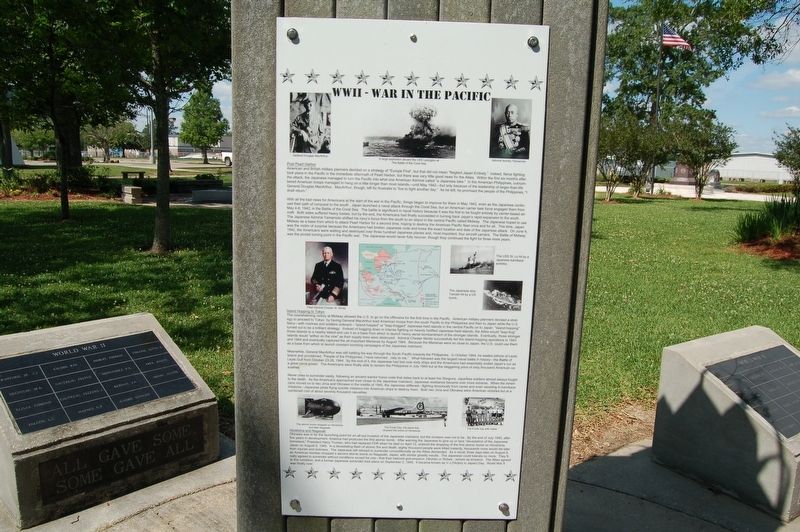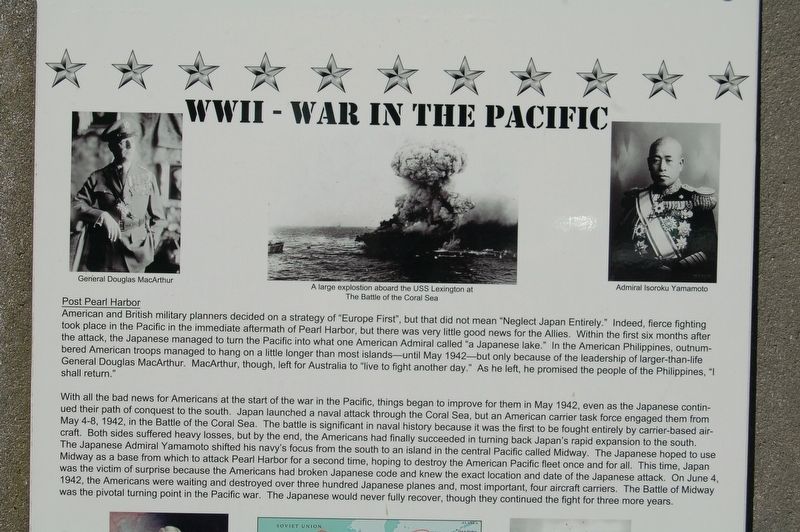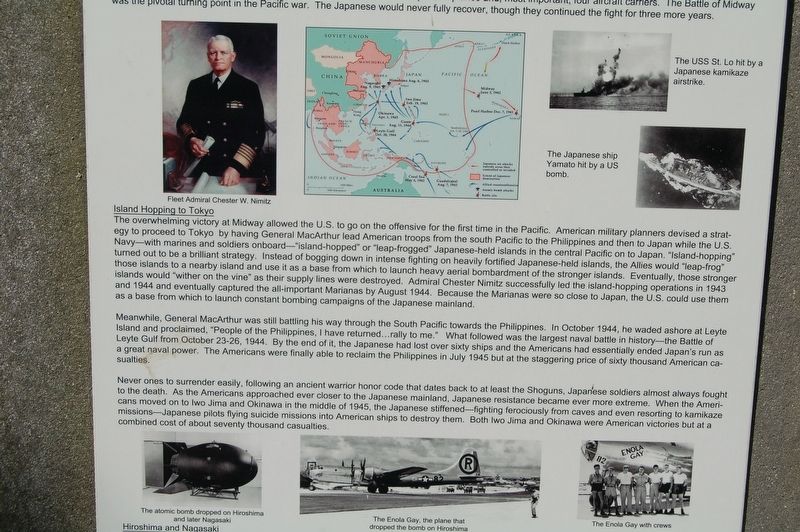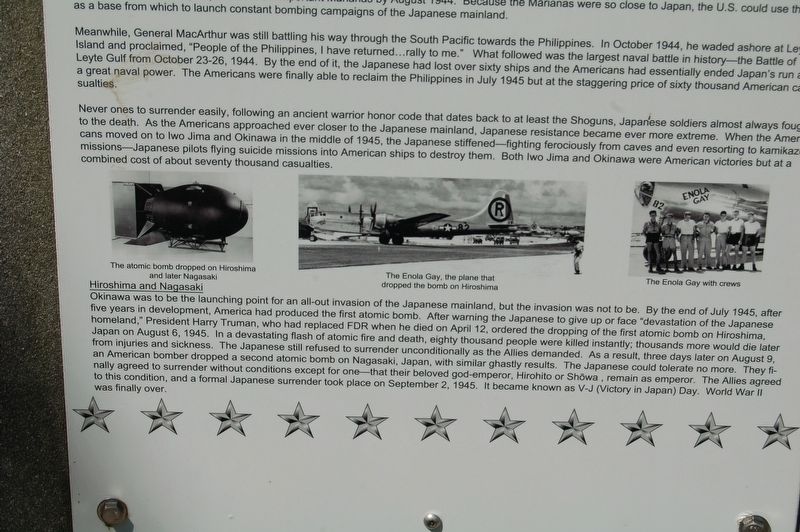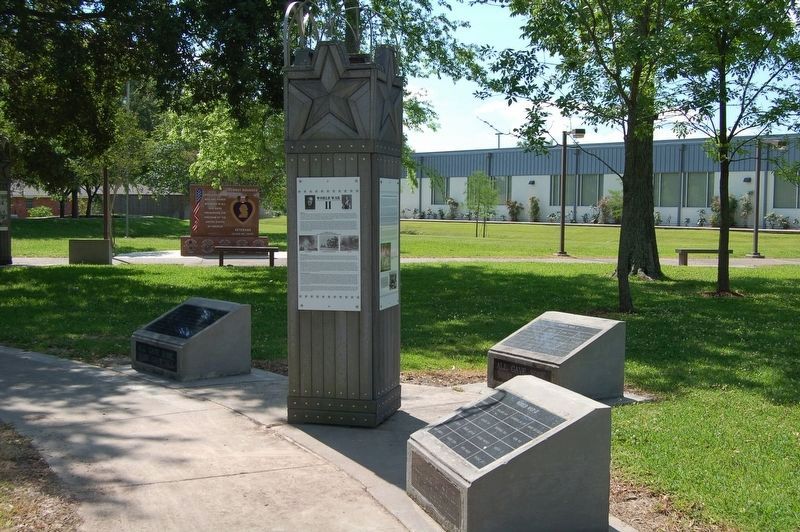WWII - War In The Pacific
Post Pearl Harbor
American and British military planners decided on a strategy of “Europe First", but that did not mean “Neglect Japan Entirely.” Indeed, fierce fighting took place in the Pacific in the immediate aftermath of Pearl Harbor, but there was very little good news for the Allies. Within the first six months after the attack, the Japanese managed to turn the Pacific into what one American Admiral called “a Japanese lake.” In the American Philippines, outnumbered American troops managed to hang on a little longer than most islands—until May 1942—but only because of the leadership of larger-than-life General Douglas MacArthur. MacArthur, though, left for Australia to “live to fight another day." As he left, he promised the people of the Philippines, “I shall return."
With all the bad news for Americans at the start of the war in the Pacific, things began to improve for them in May 1942, even as the Japanese continued their path of conquest to the south. Japan launched a naval attack through the Coral Sea, but an American carrier task force engaged them from May 4-8, 1942, in the Battle of the Coral Sea. The battle is significant in naval history because it was the first to be fought entirely by carrier-based air- craft. Both sides suffered heavy losses, but
by the end, the Americans had finally succeeded in turning back Japan's rapid expansion to the south. The Japanese Admiral Yamamoto shifted his navy's focus from the south to an island in the central Pacific called Midway. The Japanese hoped to use Midway as a base from which to attack Pearl Harbor for a second time, hoping to destroy the American Pacific fleet once and for all. This time, Japan was the victim of surprise because the Americans had broken Japanese code and knew the exact location and date of the Japanese attack. On June 4, 1942, the Americans were waiting and destroyed over three hundred Japanese planes and, most important, four aircraft carriers. The Battle of Midway was the pivotal turning point in the Pacific war. The Japanese would never fully recover, though they continued the fight for three more years.Island Hopping to Tokyo
The overwhelming victory at Midway allowed the U.S. to go on the offensive for the first time in the Pacific. American military planners devised a strategy to proceed to Tokyo by having General MacArthur lead American troops from the south Pacific to the Philippines and then to Japan while the U.S. Navy—with marines and soldiers onboard —“island-hopped” or “leap-frogged" Japanese-held islands in the central Pacific on to Japan. “Island-hopping" turned out to be a brilliant strategy. Instead
of bogging down in intense fighting on heavily fortified Japanese-held islands, the Allies would “leap-frog” those islands to a nearby island and use it as a base from which to launch heavy aerial bombardment of the stronger islands. Eventually, those stronger islands would “wither on the vine” as their supply lines were destroyed. Admiral Chester Nimitz successfully led the island-hopping operations in 1943 and 1944 and eventually captured the all-important Marianas by August 1944. Because the Marianas were so close to Japan, the U.S. could use them as a base from which to launch constant bombing campaigns of the Japanese mainland.Meanwhile, General MacArthur was still battling his way through the South Pacific towards the Philippines. In October 1944, he waded ashore at Leyte Island and proclaimed, “People of the Philippines, I have returned...rally to me." What followed was the largest naval battle in history—the Battle of Leyte Gulf from October 23-26, 1944. By the end of it, the Japanese had lost over sixty ships and the Americans had essentially ended Japan's run as a great naval power. The Americans were finally able to reclaim the Philippines in July 1945 but at the staggering price of sixty thousand American casualties.
Never ones to surrender easily, following an ancient warrior honor code that dates back to at least the Shoguns,
Japanese soldiers almost always fought to the death. As the Americans approached ever closer to the Japanese mainland, Japanese resistance became ever more extreme. When the Americans moved on to Iwo Jima and Okinawa in the middle of 1945, the Japanese stiffened-fighting ferociously from caves and even resorting to kamikaze missions-Japanese pilots flying suicide missions into American ships to destroy them. Both Iwo Jima and Okinawa were American victories but at a combined cost of about seventy thousand casualties.Hiroshima and Nagasaki
Okinawa was to be the launching point for an all-out invasion of the Japanese mainland, but the invasion was not to be. By the end of July 1945, after five years in development, America had produced the first atomic bomb. After warning the Japanese to give up or face “devastation of the Japanese homeland,” President Harry Truman, who had replaced FDR when he died on April 12, ordered the dropping of the first atomic bomb on Hiroshima, Japan on August 6, 1945. In a devastating flash of atomic fire and death, eighty thousand people were killed instantly; thousands more would die later from injuries and sickness. The Japanese still refused to surrender unconditionally as the Allies demanded. As a result, three days later on August 9, an American bomber dropped a second atomic bomb on Nagasaki, Japan, with similar ghastly
results. The Japanese could tolerate no more. They finally agreed to surrender without conditions except for one that their beloved god-emperor, Hirohito or Shõwa , remain as emperor. The Allies agreed to this condition, and a formal Japanese surrender took place on September 2, 1945. It became known as V-J (Victory in Japan) Day. World War II was finally Over.Topics and series. This memorial is listed in this topic list: War, World II. In addition, it is included in the Former U.S. Presidents: #32 Franklin D. Roosevelt, the Former U.S. Presidents: #33 Harry S. Truman, and the Lost at Sea series lists.
Location. 30° 13.707′ N, 90° 54.782′ W. Marker is in Gonzales, Louisiana, in Ascension Parish. Memorial can be reached from South Irma Boulevard, 0.3 miles north of East Worthey Street, on the right when traveling north. Touch for map. Marker is in this post office area: Gonzales LA 70737, United States of America. Touch for directions.
Other nearby markers. At least 8 other markers are within walking distance of this marker. World War II (here, next to this marker); WWII - War In The Mediterranean (here, next to this marker); WWII - War In Europe (here, next to this marker); A View From The Trenches: A Doughboy From Donaldsonville Writes Home (a few steps from this marker); World War I (a few steps from this marker); "The War to End War" (a few steps from this marker); The Vietnam War (a few steps from this marker); The Freedom Fountain (a few steps from this marker). Touch for a list and map of all markers in Gonzales.
More about this marker. Located in the Gonzales Memorial Veterans Park
Credits. This page was last revised on April 1, 2018. It was originally submitted on April 1, 2018, by Cajun Scrambler of Assumption, Louisiana. This page has been viewed 227 times since then and 14 times this year. Photos: 1, 2, 3, 4, 5. submitted on April 1, 2018.
